I confess to a half-hearted shock when, leafing through the latest issue of the scholarly journal Artibus et historiae (80, 2019), I came across an article by Keith Christiansen entitled Thoughts Regarding Two Lost Portrait Covers by Lorenzo Lotto. Keith Christiansen, Chairman of European Painting at the Metropolitan in New York, is one of the world’s leading specialists on Italian art of the Renaissance and Baroque periods. He had already published a couple of astonishing essays on Lotto: on the unbelievable Venus with Cupid from his museum and on a differently puzzling Fall of the Titans from a private collection, from the master’s last period. Now he presents to the attention of the scientific community no original, but only two copies: but what copies, and with what history.
Let us start from the beginning. In the mid-seventeenth century, the richest collection of Italian painting in Europe was that of Archduke Leopold Wilhelm of Habsburg, with 517 works, one more formidable than the other. He had begun it when he was regent of Flanders, also availing himself of the collaboration of the painter David Teniers the younger. When he returned to Vienna in 1656, he was so proud of such a collection that he commissioned Teniers to represent him in huge rooms overflowing with paintings, all of them perfectly recognizable (by Antonello, Bellini, Giorgione, Titian, Raphael ): he used such canvases not only for self-celebration but also to make gifts of a diplomatic nature (fig. 1). He also wanted Teniers to oversee the publication of a hefty volume illustrating 243 Italian paintings, engraved by twelve northern artists from 1656 onward, based on small panel models prepared by Teniers himself. That volume, entitled Theatrum pictorium, was printed in 1660 and again in 1673 and 1700. Loose sheets of it are often encountered because it was (and still is) dismembered by unscrupulous merchants to sell the engravings individually. In numbers 30 and 31 of the Theatrum pictorium one encounters a strange pendant attributed to Correggio, whose measurements are specified: 3 palms high, by 2 wide, corresponding to 60.3 x 43.7 cm (figs. 2, 3). Fortunately, the two corresponding models of Teniers, on which Christiansen’s study is centered, have also come down to us: the one for table 30 is in the Johnson Collection in Philadelphia, the other in the Metropolitan (figs. 4, 5). Obviously, having been copied by engraving them on copper plates, the two prints present the images in a mirror-image manner, but it is curious to find that in some of the large Leopold Galleries made by Teniers such paintings sometimes appear in the correct verso (in the specimens in the Prado, the Lazaro Galdiano Museum in Madrid and the Kunsthistorisches Museum in Vienna), other times in that of the prints (in those formerly in Lord Brownslow’s collection in London and in the Munich Pinakothek). In such cases, too, lattribution to Correggio is specified, whose name is inscribed on the frame: it is glimpsed, for example, in the detail of the Leopold Gallery at the Prado that I illustrate here (fig. 6).
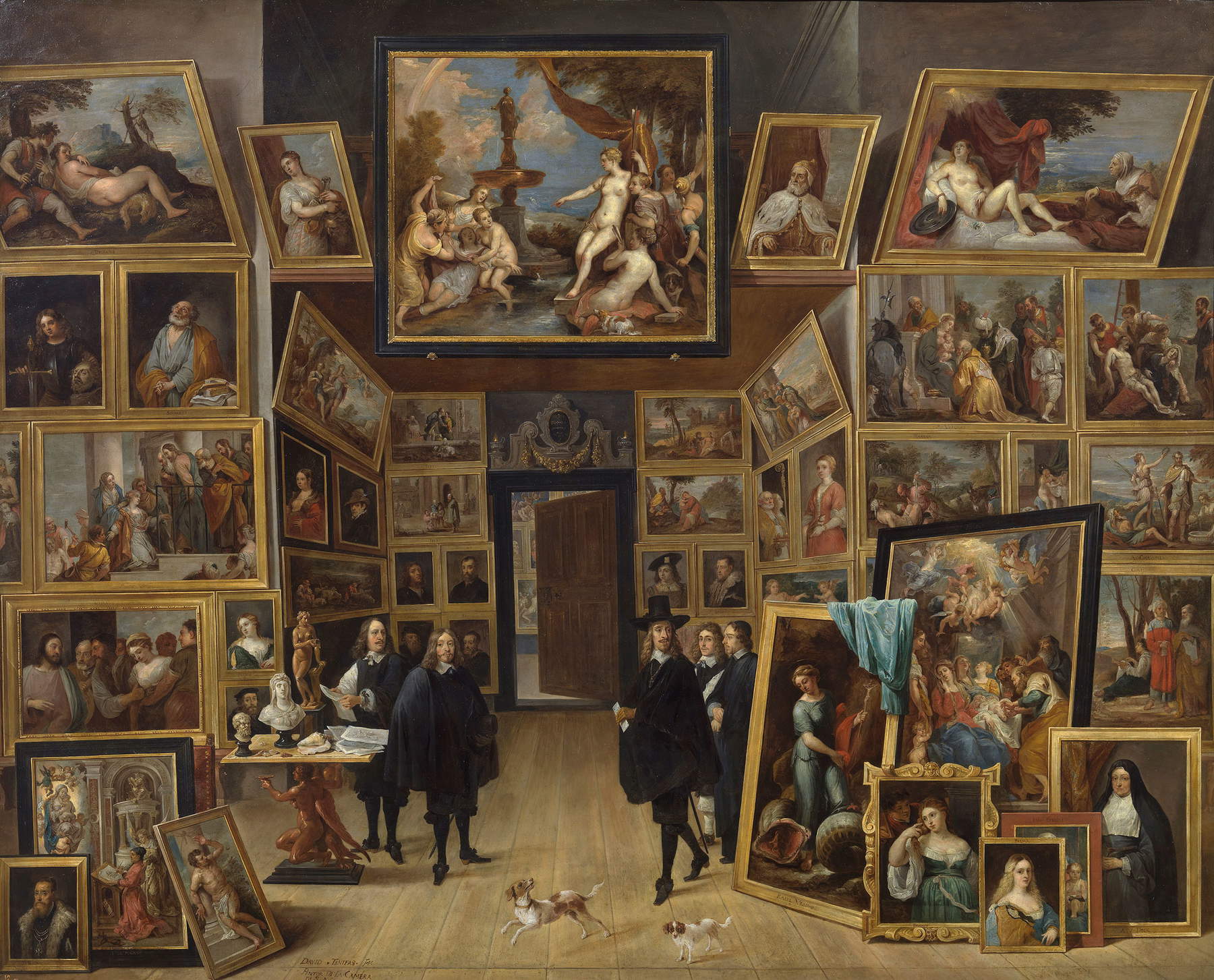 |
| 1. David Teniers the Younger, Archduke Leopold William in his Gallery (Madrid, Prado Museum). |
 |
| 2. Theodor van Kessel, from David Teniers the younger (by Lorenzo Lotto), Allegory of Lust, engraving from Theatrum Pictorium (1660) tav. 30 |
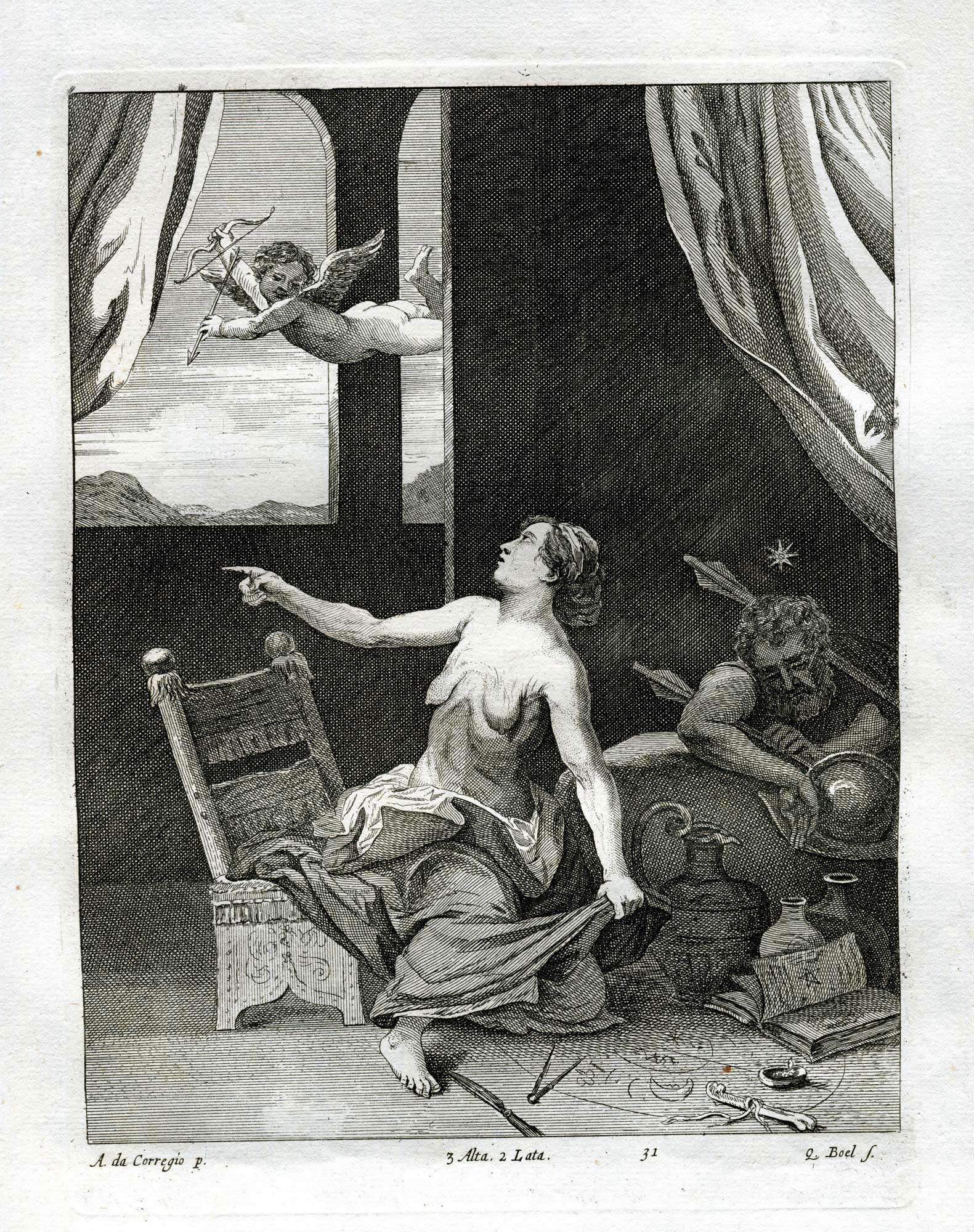 |
| 3. Querin Boel, from David Teniers the younger (by Lorenzo Lotto), Allegory of Lust, engraving from the Theatrum Pict orium (1660) tav. 31. |
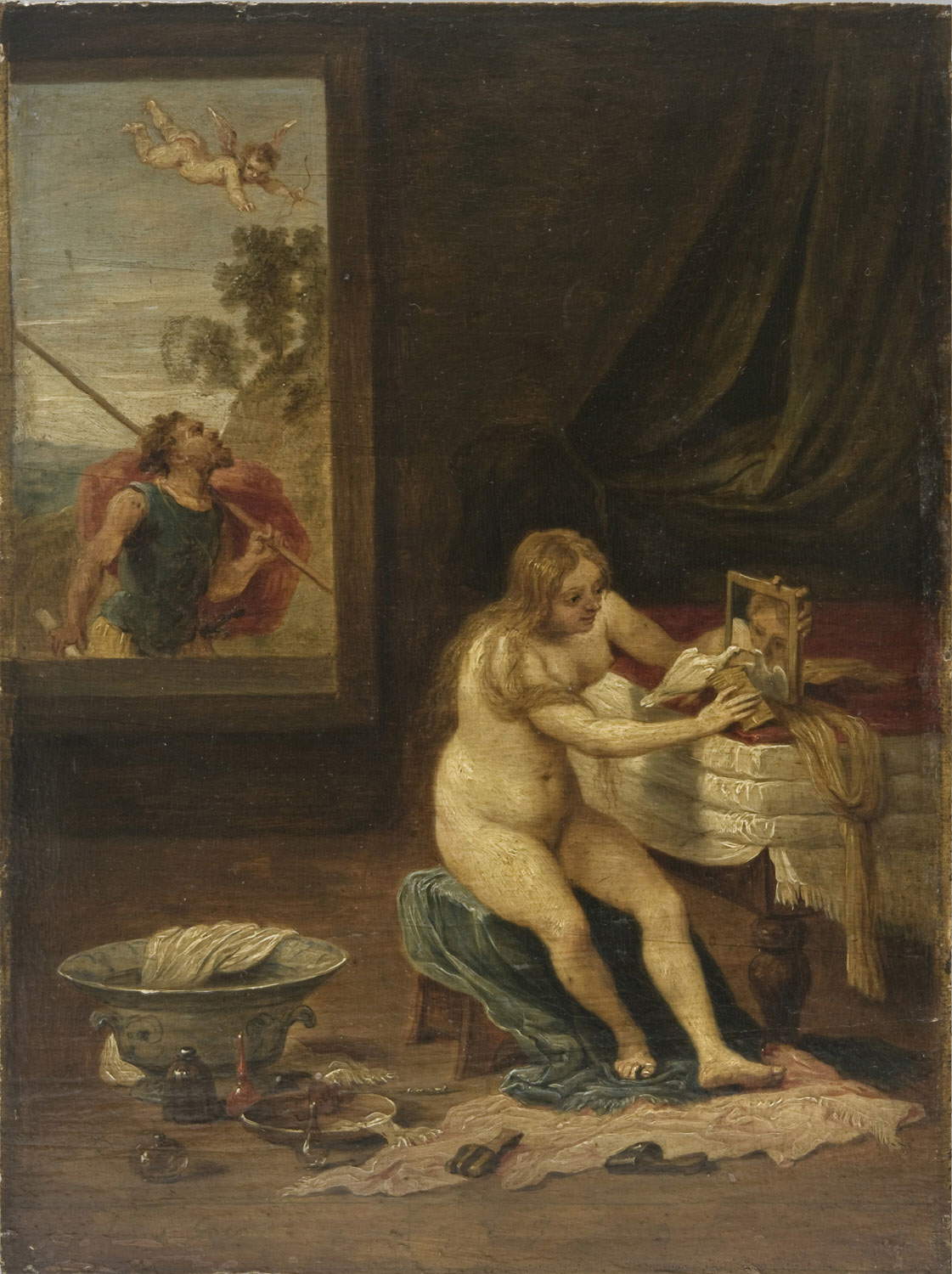 |
| 4. David Teniers the younger, from Lorenzo Lotto, Allegory of Lust (Philadelphia Museum of Art, Johnson Collection) |
 |
| 5. David Teniers the younger, from Lorenzo Lotto, Allegory of Fraud (New York, Metropolitan Museum of Art, Lehman Collection) |
 |
| 6. David Teniers the younger, Larciduca Leopold William in his Gallery, detail (Madrid, Museo del Prado) |
As Christiansen recalls, a turning point for the proper framing of these paintings came with the publication by Rosella Lauber (in an essay that appeared in Venezia Cinquecento in 2008) of the inventory of the picture gallery of one of the most important lagoon merchants of the early seventeenth century: that Bartolomeo della Nave who had looted many Venetian palaces of the masterpieces stored there. It was purchased in 1637-38 in Venice by the Englishman Basil Feilding on behalf of James, III Marquis of Hamilton and Duglas. It was accompanied by a list of works from which we learn of the existence of a nucleus of four Lottesque paintings, which are listed in sequence: at no. 120 a Pieta (lost, but of which the model by Teniers, in the Louvre, and the related print remain), at no. 121 a beautiful Cathedral Portrait with a Zattina doro in his hand (the presumed Leonino Brembate now in the Kunsthistorisches Museum, Vienna), at no. 122 La Lascivia represented in Venus, Mars et Amore 2 ½ wide 1 ½ by the same [Lotto], and at no. 123 La Fraude represented in Circe, with a sleeping man, et Amore of the same size, and by the same Lotto. Since the measurements correspond, it goes without saying that these are the supposed Correggio, which before that (and this is inferred from an inventory of Leopold’s collection drawn up in 1659) had been believed to be by Jacopo Palma the Elder. While many masterpieces put together by Leopold can still be seen today in the Kunsthistorisches Museum, others were alienated: and that was the fate that befell this pendant as well. The last information we have is that one of the two canvases (we do not know which one) at the end of the 19th century was in the Péteri collection in Budapest, where it was considered to be from the circle of Annibale Carracci.
As also pointed out by Jeremy Wood in an essay on the Bartolomeo della Nave collection that appeared in Walpole Society volume 80 (2018), the two paintings compose a narrative continuum. In the panel now in Philadelphia, Venus appears in the bedroom, waiting for Mars, who is led there by Cupid, as seen in the open window. Having washed and perfumed herself, the goddess was combing her hair when a dove alights in front of the mirror, extending its beak to coo with its own reflection: an iconographic unicum, alluding to the allimminent amorous union. In the other painting we see Mars asleep in bed, with the woman clamorously aged: after performing some magical practices, using the volume and objects laid on the floor, she orders Cupid to go and strike a new possible lover, given the discouraging disinterest on the part of Mars. According to Christiansen, who places the execution of the two originals in a very broad chronological span (between 1525 and 1542), these were probably the covers of a double portrait of the couple, made in order to remind the couple of the awareness of the inevitable physical decay (and desire) that awaited them as the years went on.
I confess that I have never seen anything like this in early 16th-century Italian painting. To know that they were made before 1556 of the artist’s death is disorienting, to say the least. Had it come down to us, and perhaps in good condition, this pendant would have the same cultural-historical importance as Bronzino’s Allegory ofLove and Fraud in the National Gallery in London.
But what makes the two scenes even more extraordinary and almost unbelievable are the settings and still lifes depicted in them. Beyond the fact that descriptions of interiors are very rare in 16th-century Italian painting (as opposed to what is recorded in the Netherlands and Flanders), and therefore that entering two Venetian bedrooms of these years is an almost unique opportunity, it is precisely the objects described one by one by the artist that surprise us (figs. 7, 8). In the first we see a large blue-and-white ceramic basin, inspired by Chinese porcelain, where the cloth with which the goddess dried herself after her ablutions has been thrown; underneath is the basin in which she washed her feet, and around it many little bottles of perfume with which she will intoxicate the intoxicating Mars who is about to burst into the room. In the second, on the other hand, the foreground shows a diagram marked on the ground, with some magic circles, a brazier with a lit flame, a bone with a knotted rope, a compass, a knife and an open Kabbalistic book. Now, we know with certainty that from his earliest activity Lorenzo Lotto had been in contact with humanist-alchemists, the most famous of whom was the Rimini-born Giovanni Aurelio Augurello, of whom in Treviso (c. 1505-06) he had painted a portrait with cover. On this dimension of the painter’s culture one of the master’s best-known specialists, Francesca Cortesi Bosco(Viaggio nellErmetismo del Rinascimento. Lotto Dürer Giorgione, Il Poligrafo, 2016). But from there to imagine such a thing
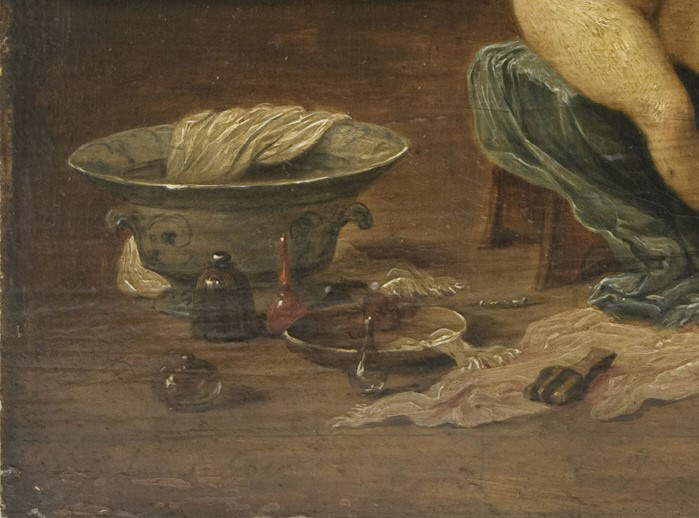 |
| 7. David Teniers the younger, from Lorenzo Lotto, Allegory of Lust, detail (Philadelphia Museum of Art, Johnson Collection) |
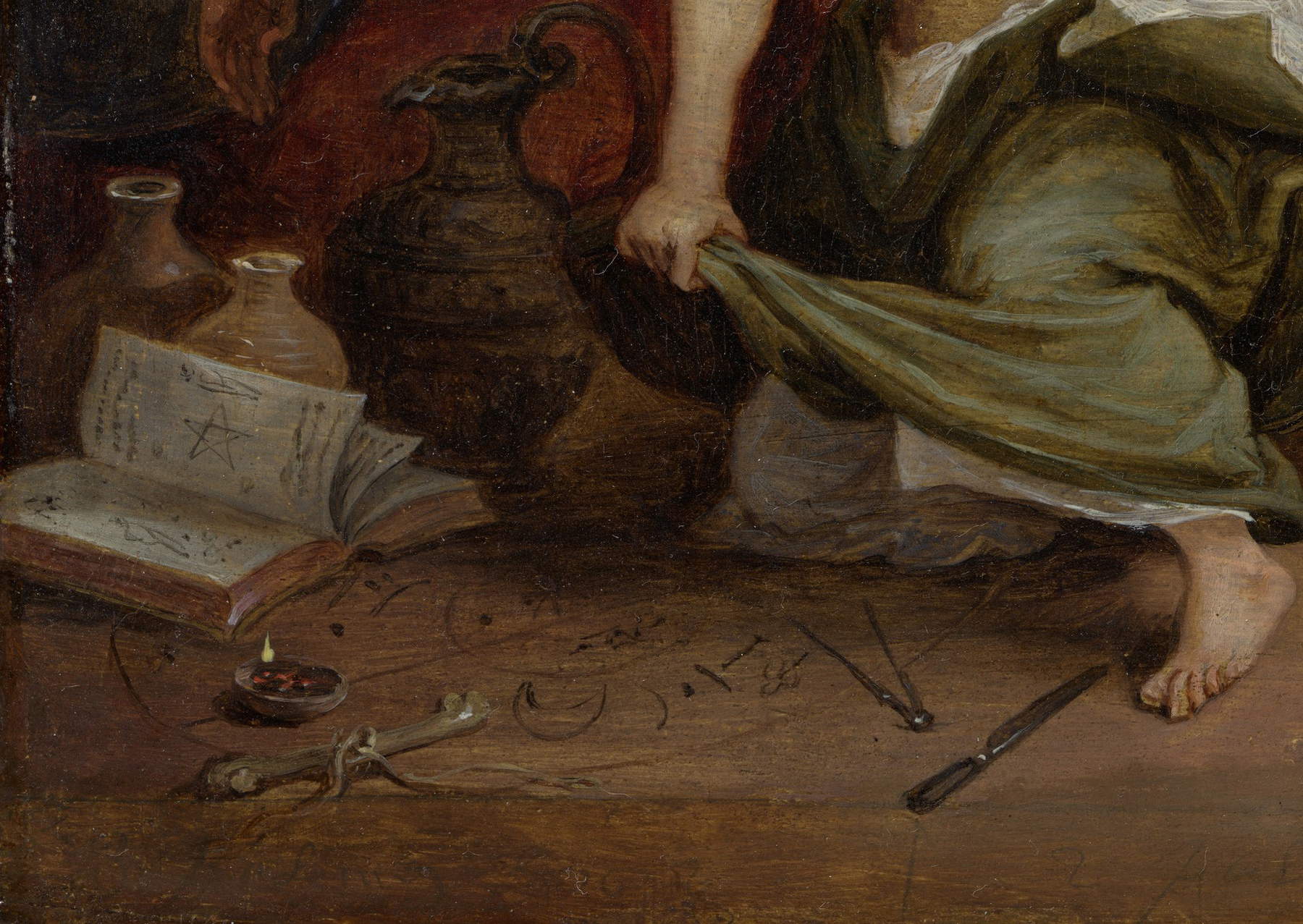 |
| 8. David Teniers the younger, from Lorenzo Lotto, Allegory of Fraud, detail (New York, Metropolitan Museum of Art, Lehman Collection) |
Here, then, even two copies can mark a turning point in our knowledge of an ancient painter who has experienced an ever-increasing fortune in recent decades, not only because of his very high technical qualities but also because of the degree of creative originality exhibited. I admit that I have always been rather skeptical reading alchemical and magical analyses related to his production; but at this point it goes without saying that he was familiar with these practices, had the texts in his hands, knew that they were commonly used in certain situations, such as those to summon a loved one
In more detail, the circle drawn on the floor is a pentacle, very similar to those found in the records preserved in the trials of the SantUffizio, as Federico Barbierato, author of a seminal study on such issues for the lagoon area, points out to me(In the Room of Circles. Clavicula Salomonis and books of magic in Venice in the 17th and 18th centuries, Milan, Bonnard 2002) (figs. 9-10). The tools used for levocation included stilettos, awls, and such implements: this explains the presence of a knife in the foreground of the painting. Losso undoubtedly connotes the scene as necromantic: usually a skull was used (and this is clearly seen in some later Venetian paintings by Pietro della Vecchia and Giuseppe Heintz the younger: not coincidentally, the author to whom Pigler had attributed the Metropolitan painting), but the meaning is the same. The small brazier probably contained red wax, habitually used to build small statues used for what we would today call voodoo purposes. On such an episode Guido Ruggiero wrote an essay in a volume of Quaderni storici in 1987, in which he told the story of the one found in May 1588 in the cathedral of Feltre, which simulated a naked man, with fixed many needles in all parts of said statue, maxims neglocchi, in the temples, in the parts of the core, et in the virile member: it had been made by a certain Elena, on the advice of a sorceress, to try to get married by the beloved who had left her. As Silvia Gazzola reminds me, moreover, the pentacle is also found in Ariosto’s Necromancer, where the play’s protagonist, obviously an impostor, is called upon to resolve the (feigned) impotence of one of the main characters. Hence, in the New York painting, after doing her spell, the woman spurs Cupid to use his bow and arrow, knowing full well that all he had to do to achieve a new, lusty mate had been done.
 |
| 9. State Archives of Venice, envelope 95, case against fra Francesco Balbi: pentacles and magical characters from a Clavicula Salomonis from the first half of the seventeenth century |
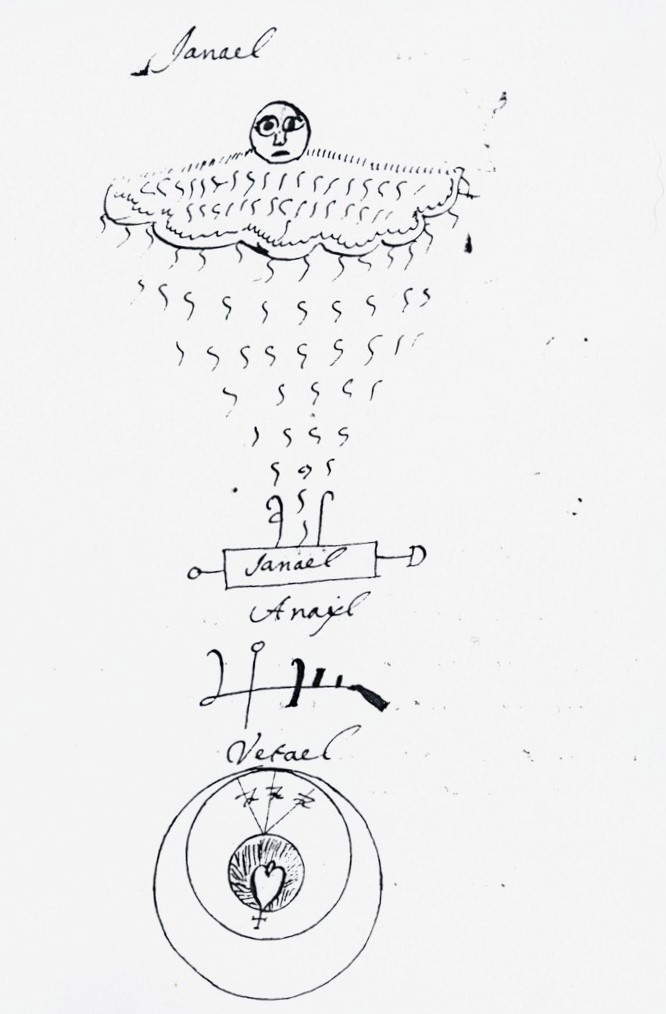 |
| 10. State Archives of Venice, envelope 9, trial against Francesco Viola: representations of certain spirits according to a Clavicula Salomonis ad sciendum secreta secretorum from the first half of the seventeenth century |
There are really many questions one can ask when confronted with these two inventions: the date of execution of the originals (they are not mentioned in the Book of Miscellaneous Expenses, which records works from 1540 onwards), the commissioner (the same as the other two paintings sold by Bartolomeo della Nave?), the actual function (I would not swear that they constituted the covers of two portraits), the reference to literary production (the theme of the aging of beautiful women is also very common in coeval poetry), etc. However, one would thus enter the realm of conjecture and specialized insights, and this is certainly not the place to do so.
However, I would like to close with one last thought, concerning the fate of the two paintings. But have they really been lost? Is it not the case that on the wall of some house or workshop (Hungarian or who knows where), hang two strange (and perhaps dirty) paintings attributed to the circle of Annibale Carracci that have been waiting for almost four centuries to be recognized in their authorship?
Warning: the translation into English of the original Italian article was created using automatic tools. We undertake to review all articles, but we do not guarantee the total absence of inaccuracies in the translation due to the program. You can find the original by clicking on the ITA button. If you find any mistake,please contact us.